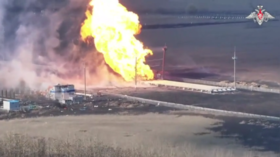Space junkyard: New tech designed to combat dangerous trash in orbit

In an attempt to keep space debris from destroying million-dollar projects in Earth orbit, Lockheed Martin is teaming up with an Australian company to track potentially dangerous wreckage.
The defense and aerospace company will develop a new tracking system capable of monitoring pieces of space junk as small as a baseball currently soaring through the Earth’s low orbit. Lockheed Martin will be working with Australia’s Electro Optic Systems (EOS) on the project, which is scheduled to be operational in 2016, according to the Financial Times.
“Even a tiny piece of space debris can seriously damage satellites worth hundreds of millions of dollars,” said Craig Smith, the EOS CEO, to the Times. “Our technology enables us to track the most dangerous pieces of space junk and provide accurate data to satellite operators, which should enable them to avoid collisions.”
In a statement issued on Monday, Lockheed Martin stated the proposed site will employ a suite of advanced sensors and software, as well as lasers, to locate and track drifting space junk. If a piece of debris is found to be particularly dangerous, then satellites can be moved in order to stay out of harm’s way.
"We'll offer customers a clearer picture of the objects that could endanger their satellites, and do so with great precision and cost-effectiveness,” said Rick Ambrose, executive vice president of Lockheed Martin Space Systems.
As noted by the Wall Street Journal, the new project will tracking system would be deployed alongside the US Air Force’s Space Fence, which already tracks about 200,000 pieces of debris. Since even space junk the size of a marble – traveling at speeds of up to 17,500 miles per hour – can cause significant damage to expensive satellites, monitoring Earth’s increasingly crowded orbit.
"There are up to 200 threats a day identified for orbiting satellites," said Lockheed Martin spokesman Trevor Thomas to the Journal. "Most satellites can sustain some damage, but little bits of junk hit satellites every day and each, on average, is worth around $500 million."
There are up to 500,000 pieces of space junk circling the planet, believed to range in size from that of a fingernail to a bowling ball. Typically, one of the 2,000 or so satellites in orbit are destroyed every year.
Of course, Lockheed Martin isn’t the only company looking to tackle the growing concern over space junk. As RT reported earlier this year, Japan is currently testing a massive, magnetic “fishing net” made of advanced metal fibers that could potentially capture space debris and drag it down into the Earth’s atmosphere, where it would be incinerated. If the tests are successful, the net could be deployed in 2019.
Russia is also working on its own “space cleaner,” a spacecraft capable of clearing 10 disabled satellites over the course of a six-month mission.
Additionally, EOS itself is designing plasma lasers that would be able to destroy space junk, with similar tech being developed in the United States.















